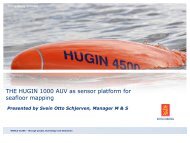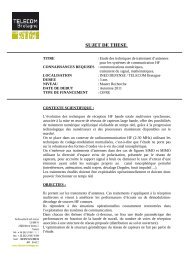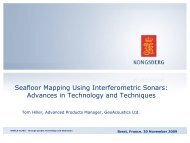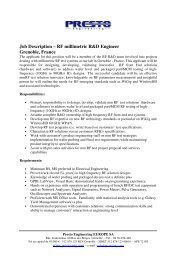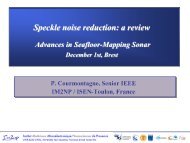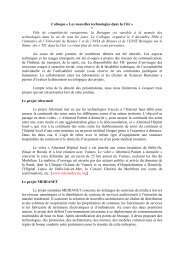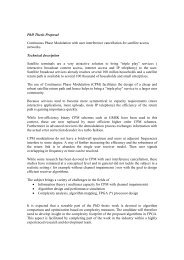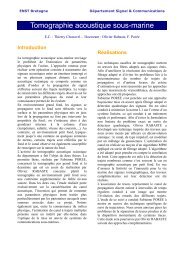schemes specifically suitable for links andtunnels where delays are high.Secondly, we presented two approaches tooptimize the use of ROHC profiles when ROHCcompression is used in NEMO n<strong>et</strong>works [2].The idea is to control the number of profilesthat both the HA and the MR have to maintainin order to manage all IP tunnels. In the firstapproach we only use the IP profile and thenhave one profile per mobile while in thesecond approach the number of profilesmaintained by the HA is considered as aresource that can be attributed or not to eachmobile (MR or MN) depending on their needs.The third part of the study focus on tunnelingcompression (TuCP) [1]. TuCP is used inconjunction with ROHC to reduce the tunneloverhead in NEMO n<strong>et</strong>works. The solution ofROHC and TuCP compression can be extendedto nested tunneling scenarios such as thosefound in nested mobile n<strong>et</strong>works (see figure 2and 3). We implemented a first version of theTuCP protocol.Figure 2. Nested Tunnels without TuCP CompressionFigure 3. Nested Tunnels with End-2-End TuCP CompressionFurther testing is ongoing for the evaluationand performance measurement of the TuCPprofiles.Figure 4. Header Compression Efficiency forROHC + TuCPWe find that header compression is moreefficient for IPv6 flows compared to IPv4flows. It is possible to achieve 66%compression efficiency for IPv6 flows (seefigure 4). The use of TuCP in conjunction withROHC in IP tunnels reduces the headeroverhead to 2 bytes. This makes tunnelingmechanisms virtually costless in terms ofbandwidth consumption.References[1] Priyanka Rawat, Jean-Marie Bonnin, AnaMinaburo, and Laurent Toutain, "An End-2-EndTunnel Header Compression Solution for NestedMobile N<strong>et</strong>works," International Conference on theLatest Advances in N<strong>et</strong>works, ICLAN'2007, Paris,Dec 2007.[2] Priyanka Rawat, Jean-Marie Bonnin, and AnaMinaburo, "Optimizing the use of Robust HeaderCompression profiles in NEMO N<strong>et</strong>works”, TheSeventh International Conference on N<strong>et</strong>working,ICN <strong>2008</strong>, Cancun, Mexico, April <strong>2008</strong>.[3] Priyanka Rawat, Jean-Marie Bonnin, LaurentToutain, and Yanghee Choi, "Robust HeaderCompression over Long Delay Links”, IEEE 67thVehicular Technology Conference, VTC<strong>2008</strong>-Spring,Singapore, May <strong>2008</strong>.4 Extract of Pracom’s Annual Report <strong>2008</strong>
Compression techniques and IPv6 for mobilityResearch Staff : Jean-Marie Bonnin, Laurent Toutain – Ph.D. students: Priyanka RawatKeywords : h<strong>et</strong>erogeneous access n<strong>et</strong>works, header compression, ROHC, Context-awarenessPartners & Funding : project funded by SFRIntroductionThe recent development of Intern<strong>et</strong> makes IPprotocolsuite unavoidable in developing newservices. Almost all applications developed lastyears (Voice over IP, Peer-to-peer, InstantMessaging, Push-to-Talk,…) use theseprotocols even for real time and mobileservices. Unfortunately, neither IP nortransport protocols (UDP, TCP) have beenspecifically optimized for scarce resourcesusually available on wireless links.Furthermore, when application data areappropriately compressed the IP and transportprotocol headers remain very consuming.This is why using compression m<strong>et</strong>hodsbecomes more and more crucial to reduce thebandwidth consumption, and therefore th<strong>et</strong>ransmission delay.ObjectivesSeveral compression protocols have alreadybeen developed. Some of them are known tobe b<strong>et</strong>ter than others but they all have a majordisadvantage: None of these techniques ismulti-purpose. In fact, the efficiency of am<strong>et</strong>hod depends closely on the kind of flow tobe compressed and on the link characteristics(statics and/or dynamics).This justifies the wide vari<strong>et</strong>y of compressionm<strong>et</strong>hods in the way that each one is suitablefor a vari<strong>et</strong>y of data and is optimal undercertain link conditions. For example, headercompression m<strong>et</strong>hod are more adapted thanpayload compression m<strong>et</strong>hods when thepayload is already compressed at theapplication level (VoIP, video, …). Some of thecompression m<strong>et</strong>hods rely on a contextmaintained at each side of the link (whichcould be PPP or other link technologies such asSNDCP in GPRS or PDCP in UMTSarchitectures). These m<strong>et</strong>hods are then verysensitive to transmission errors: they areunable to rebuild original data since bothcontexts become desynchronized.To overcome the difficulty to choose onecompression m<strong>et</strong>hod for all flows during all theduration of a session, a suitable solution wouldbe to choose dynamically and automaticallythe most suitable compression m<strong>et</strong>hodregarding the flow type and linkcharacteristics. One of the aims of this projectis to design and evaluate an algorithm able toaccomplish this task [2].One of the most promising compressiontechniques is header compression such asROHC [1], especially when the user flowtransport information already compressed atthe application level. This is why the projectalso aims at evaluating the behavior of a ROHCimplementation over actual UMTS/GPRSaccess.RealizationWe integrated ROHC/TCP profile (RObustHeader Compression for TCP) proposed byIETF in our study. We implemented ROHC/TCPin order to evaluate its characteristics and itsperformances. It is an important compressionm<strong>et</strong>hod since it allows a significant overheadreduction for signaling traffics, which often useTCP as transport protocol, especially onIMS/UMTS n<strong>et</strong>works.In a study of ROHC behavior over IPv4UMTS/GPRS access we show that it is reallyefficient to send IPv6 traffic over a L2TP tunnelusing ROHC header compression; Almost asefficient as using directly IPv6 over GPRSaccess.A patent related to the automatic selection ofthe most adapted compression techniques ison the way with SFR.References[1] A. Couvreur, A. C. Minaburo Villar, L. LeNy, G. Rubino, B. Sericola, L. Toutain,"Performance analysis of a headercompression protocol: the ROHC unidirectionalmode", Telecommunication systems, Vol. 31,N° 1, p. 85-98, 2005.[2] R. Ben Rayana, J.-M. Bonnin, A. Belghith.“Sélection dynamique des protocoles decompression”, CFIP’2006 (ColloqueFrancophone sur l’Ingénierie des Protocoles),Tozeur, Tunisie, November 2006.Extract of Pracom’s Annual Report <strong>2008</strong> 5



